Hello once again, dear readers.
At around March 2002, for one reason or another, Crytek were dropping the older concept of their future game — they were dropping X-Isle, with all its aliens, dinosaurs and everything else. Thus, they needed a new vision for their upcoming tactical shooter on their (at the time) cutting-edge engine. And what they created in response to this need turned out to be the first rough drafts for what would in the end become Far Cry.
In this article, you can take a look at a summary of how the developers envisioned various aspects of Far Cry in the very beginning, before the E3 2002 demo was even really made. Locations, characters and mutants, crazy game mechanics, all never seen in any other material — you can find out about all this here.
And a bit of stuff from later periods too.
This time, the article isn’t that overloaded with images at all. Rather, I should warn you that it is going to be a giant wall of text.
Game title
How you name a yacht is how it is going to sail. Thus, the developers spend a lot of effort to find a suitable name for their game. And oh boy, did they go through some wildly different versions:
-
7th Heaven
This title was soon rejected, because it implied a limitation upon the mission design — seven islands. And so, an alternative title was suggested...
-
SPLICED
This title alludes to the mutant theme of the game, which, as you will soon find out, was there all along. Perhaps, it was rejected because it spoiled the eventual encounter with the mutants?
-
EVOLVED
Another alternative title mentioned, that also plays with the mutant theme.
In the end, someone from Ubisoft came up with “Far Cry”, Crytek decided that it was good, and so it stuck — the title that is distinct and memorable, the title that is now inseparable from the game itself, the title that spawned a franchise.
Okay, now we know the story of the game’s title. But what were the general ideas about the game’s setting at that time?
Setting and locations
The game was to be set in the 2010s (or 2020s) — in the near future, 10-20 years from the time the game was being envisioned and made.
The game was to be set on an archipelago somewhere in the Pacific. The setting — a familiar mix of tropical paradise and DooM 3-esque spooky, claustrophobic lab complexes, with an occasional ancient ruin — was mostly unchanged.
There are, however, some key differences from the release version.
Notably, all structures left by the Japanese from WW2 were absent from the plan at the time. So, no tanks and planes in the jungle, no Carrier, no Fort, and many other things. This means they were added at some later point during the development.
Besides the lack of one crucial element of the setting, there was a couple of new locations to be potentially included. A skeletal village with frightened and suspicious inhabitants. An abandoned/failed hotel resort that is now being consumed by the natural landscape. All of this is something that we have never ever seen in the final game. Or the builds, screenshots and footages, for that matter. And they would be of... some importance to the story, so more on them later down the article.
Oh, and by the way, some of the island’s names were:
- Cabatu
- Amulong
- Pagao
- Jacutan
Characters
While most of the cast would be easily recognizable to you, there are a couple of new roles as well, and the familiar characters are ever so slightly different too.
The Protagonist
One of the other inseparable aspects of the original Far Cry is its main character, Jack Carver.
His name, not unlike the title, went through a whole lot of wildly varying versions:
-
Zachary Roarke
-
John Wallace
-
Tom McCallister
-
Conrad Corvine
-
Wolfe Stern
-
Eric Carver
and, finally
-
Jack Carver
First, let’s talk about his appearance.
The initial draft of his appearance was something like this: a white man in his 30s, tanned, lean and fit but not overly muscular, with short black hair, dressed in light-gray pants, a plain close-fitting black shirt, black army boots. Right-handed with metallic / chrome watch on left arm. He looks like he has just woken up after a night of serious drinking: he needs a shave, his hair is not groomed, messy.
This is slightly different from the release version — and remarkably close to this particular concept of our protagonist that we’ve shown you in the previous part:

A bit later his description changed to resemble the final version more.
He would finally get the signature Hawaiian t-shirt (not yet clear what would be the colour), his hair were now more blonde, sun-bleached. He would now have a broken nose and a scar splitting his left eyebrow due to an adventurous life. His appearance would slightly change as he picks up equipment from the enemies.
In essence, his appearance was now closer to what we’ve seen in the 2002 E3 demo, and to these concepts:

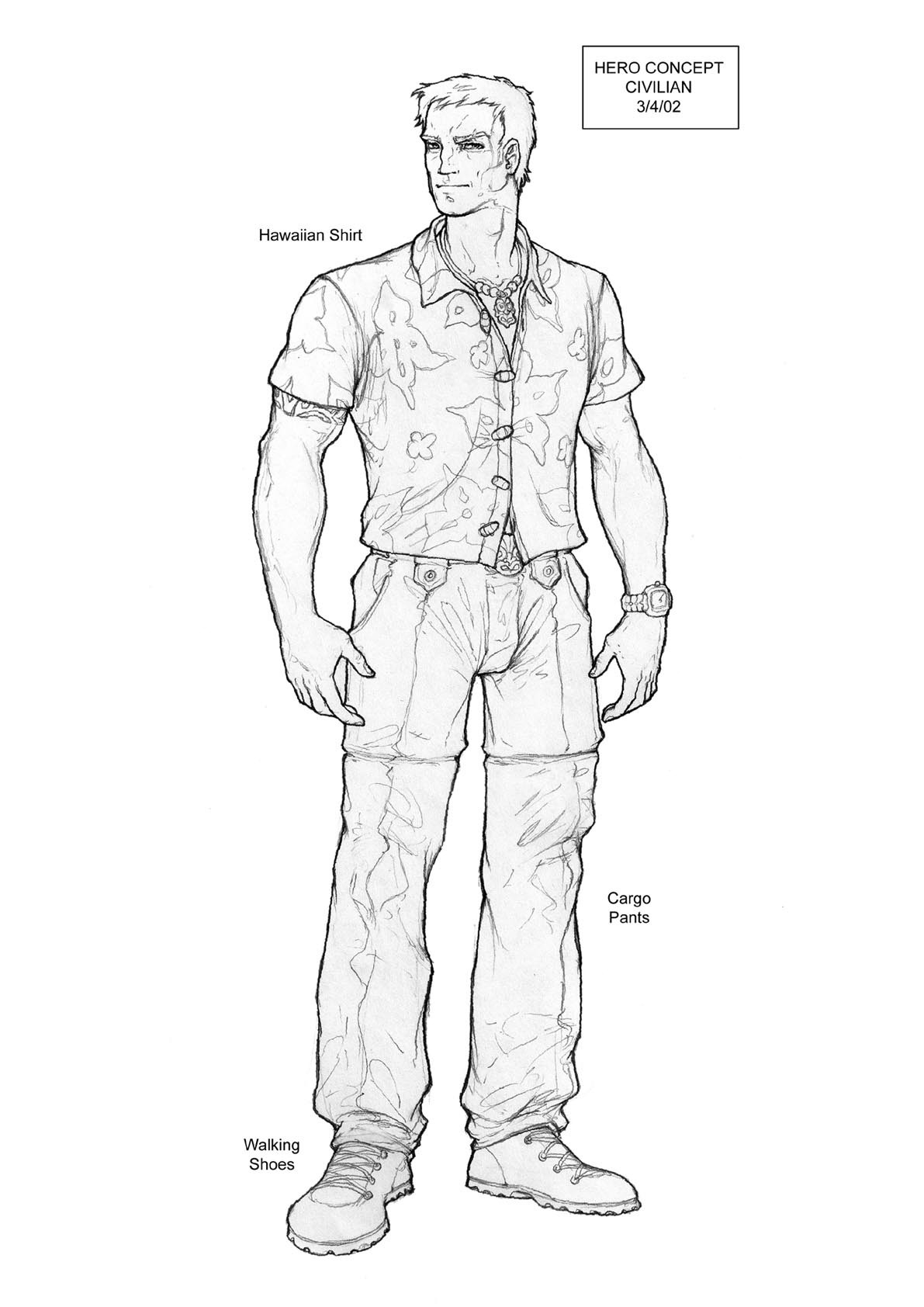
And the final game’s design generally evolved from this version.
What would the protagonist do normally, prior to the game?
He would run a small charter operation in the South Pacific which would provide his main income — transporting tourists and small cargo amongst the islands — generator parts, radios, medical equipment, etc. On the side he would occasionally smuggle rum. He would sometimes do “odd” jobs for people when he needs the money, or is bored and looking for something new.
Nothing too different here.
And finally, let us talk about what kind of personality he was planned to have.
Adventurous, trained and adaptable. Does not risk his life for nothing. With a laid-back, slightly world-weary personality. His dry, dark sense of humor would be expressed in cynical comments, even under the most difficult circumstances. Although he can become angry if provoked, the protagonist generally remains cool under pressure and would rather diffuse a tense situation than start a fight.
Sounds familiar, right?
While a lot of his traits as a character generally remained the same, a lot more emphasis was given on him having a somewhat ambiguous dark past that would give him some sort of an internal conflict that would be resolved during the course of the game. His image in general was somewhat darker and more dramatic: a loner, a “dark saint” living by his own set of rules, which reminds me of this “Load last checkpoint” image background
(original and our remake)
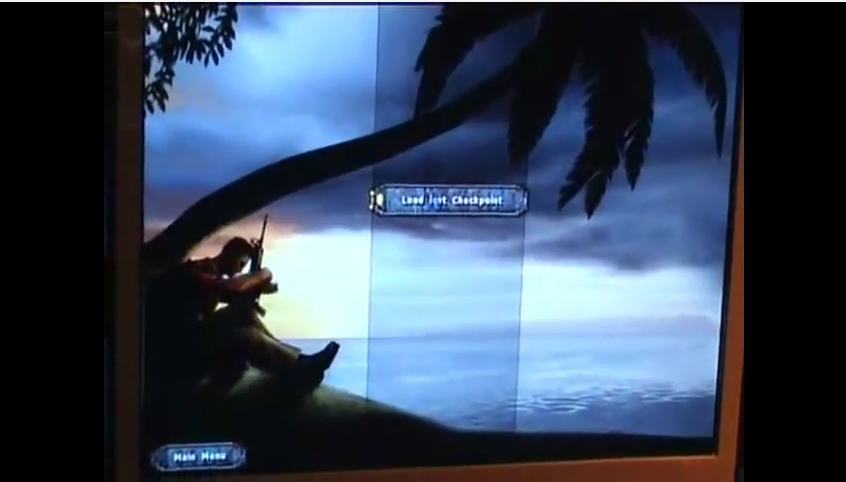
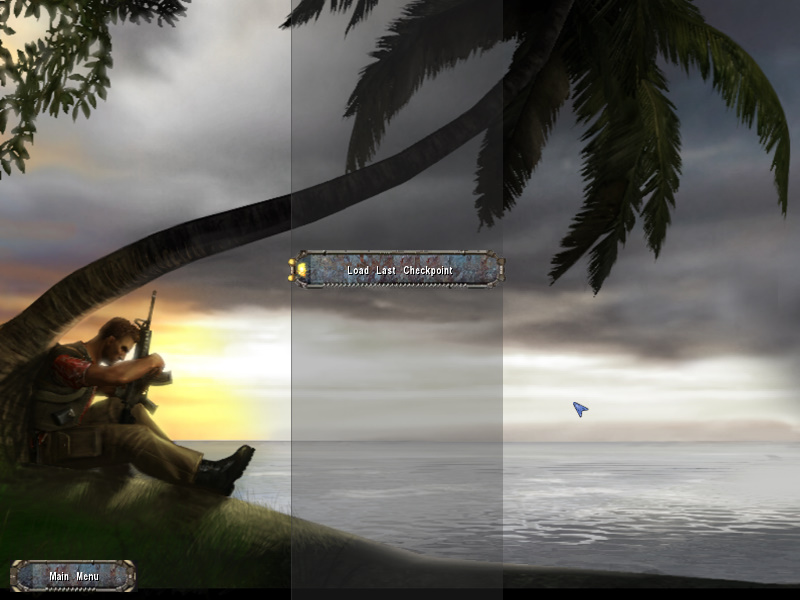
Main characters
In this category I included all the characters that are named and important to the plot of the game.
The antagonist (Krieger prototype)
Again, mostly quite similar to what we have now. However, some of his motivation and personality is described in greater detail.
His name went through these versions:
-
Professor Panariti
-
Valdemar Krieger
The last one was in use for quite some time during development, but it was eventually changed into the “George Wilhelm Krieger” we know now.
So, what kind of a main villain was envisioned at that time?
A brilliant scientist in the field of genetic engineering. His work has provided him with a fortune. But his true desire lied in finding a “cure” for the imperfection of humanity — engineering a superior species, a replacement for the evolutionary dead-end that he believed mankind to be. And to achieve this dream, he used his accumulated wealth for building self-sustained research complexes on several remote islands in the Pacific, away from prying eyes and ethical restraints, and for recruiting scientists and “security”, competent and unscrupulous enough for the task. As a PR front he created “Krieger Industries”, stated to be a company with a purpose of making cures for genetic diseases and such. And to incentivise other nations to look the other way, he bribed them with unique fruits of his labour — military grade biological weapon systems, like viruses and soldier “enhancements”.
His appearance was described like this: a man around his forties, solid in stature (large, yet not muscular), with bushy eyebrows and an intense stare. Dressed in clothes more appropriate to the controlled environments of the research facilities rather than the tropics: black shoes, brown pants, and a black turtleneck. His appearance would radiate an aura of intelligence and power.
His personality was described like this: a man that needs complete control over his surroundings and himself, with a tight reign over his emotions, disciplined. Driven by an idealistic dream, differing very much from a sane man’s reality. Both a genius and a lunatic in one person.
(As a side note, he was in some part inspired by the antagonist of “Apocalypse Now”.)
As you can see, that does not differ much from the character that we see in the final game.
And just like the final game, he intends to put the total sum of his research into his own body, becoming an “ultimate mutant”. But I want to point out that this transformation, unlike the final game, was envisioned to be a gradual and, most importantly, a noticeable process: the player would see his appearance change with subsequent encounters. That ties well with the images of an “intermediate” stage of Krieger’s transformation that were shown in part 8:
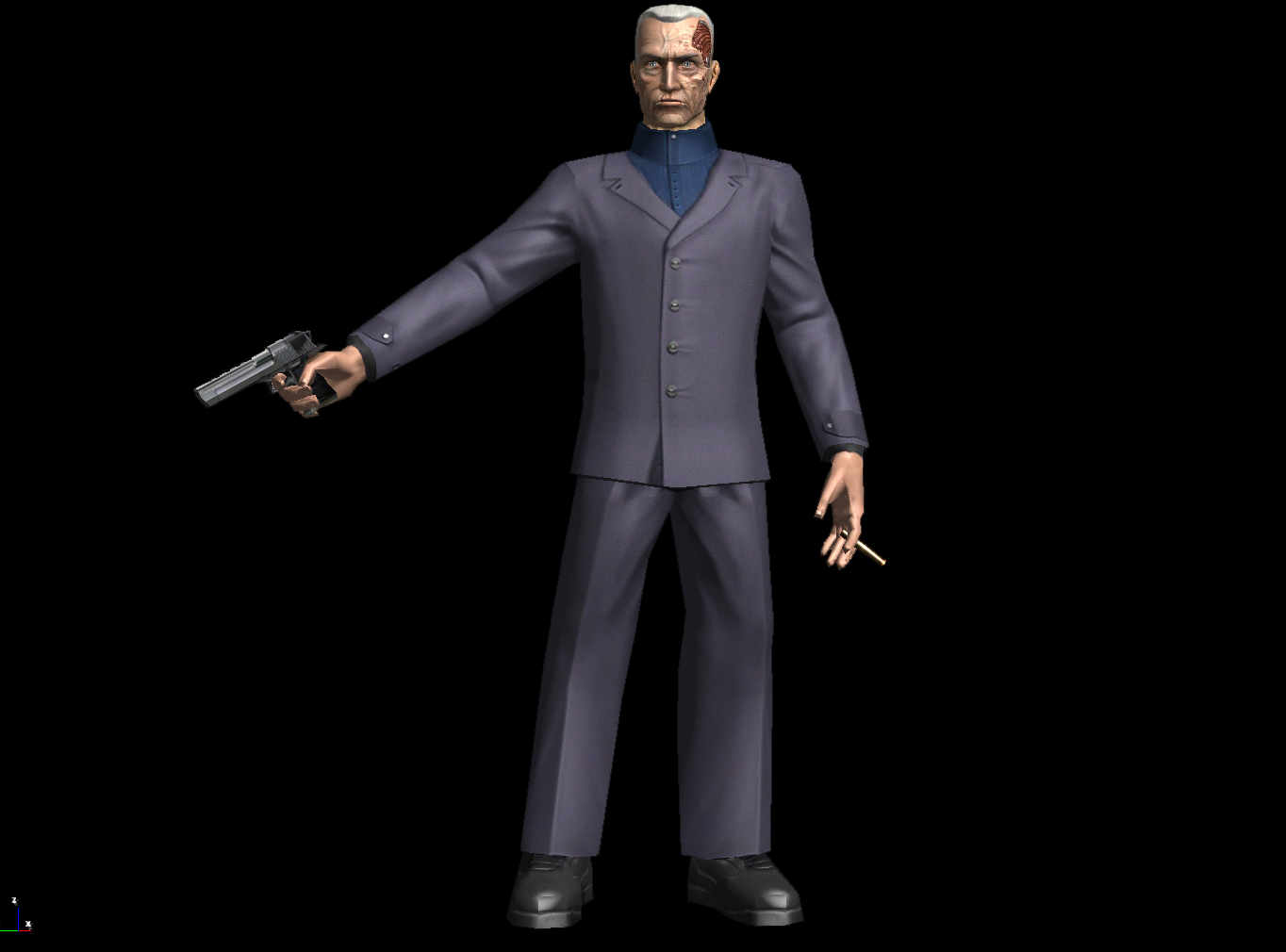
The female journalist (Val prototype)
Her name went through these versions:
-
Cathy Miller
-
Valerie Locklin
The latter also stuck for a while — at least until 2003, in fact, which can be deduced by looking at various Far Cry-related news from 2003:
Then, at some later point, she was named Valerie Cortez, and then, finally, the name settled on the one we know — Valerie Constantine
So, what was she like at that time?
As you can probably tell, she is a journalist. Intelligent, independent. She knows what she wants and is not afraid to go after it. Curious, always looking for the next big, headline-making story to put her name next to. In addition, she is someone who is intrigued by dangerous situations.
Nothing wildly different there either. However, one important thing to note is the lack of any hint about her actually working for the CIA, which is a rather important plot point in the final game. When the game was just being envisioned, however, she was just a more or less normal journalist that was too curious for her own good.
Her appearance was described like this: shorter than the hero by a head height, with a slim athletic build, lightly tanned. Dressed in light-brown boots, light gray shorts, a tight matching shirt. Her medium-length deep brown hair are tied back in a ponytail
One quite notable thing is the presence of glasses — silver wire-frame glasses with round lenses. As we’ve seen in part 8, glasses were an important part of her appearance for quite some time during the development (though they never really matched the description):
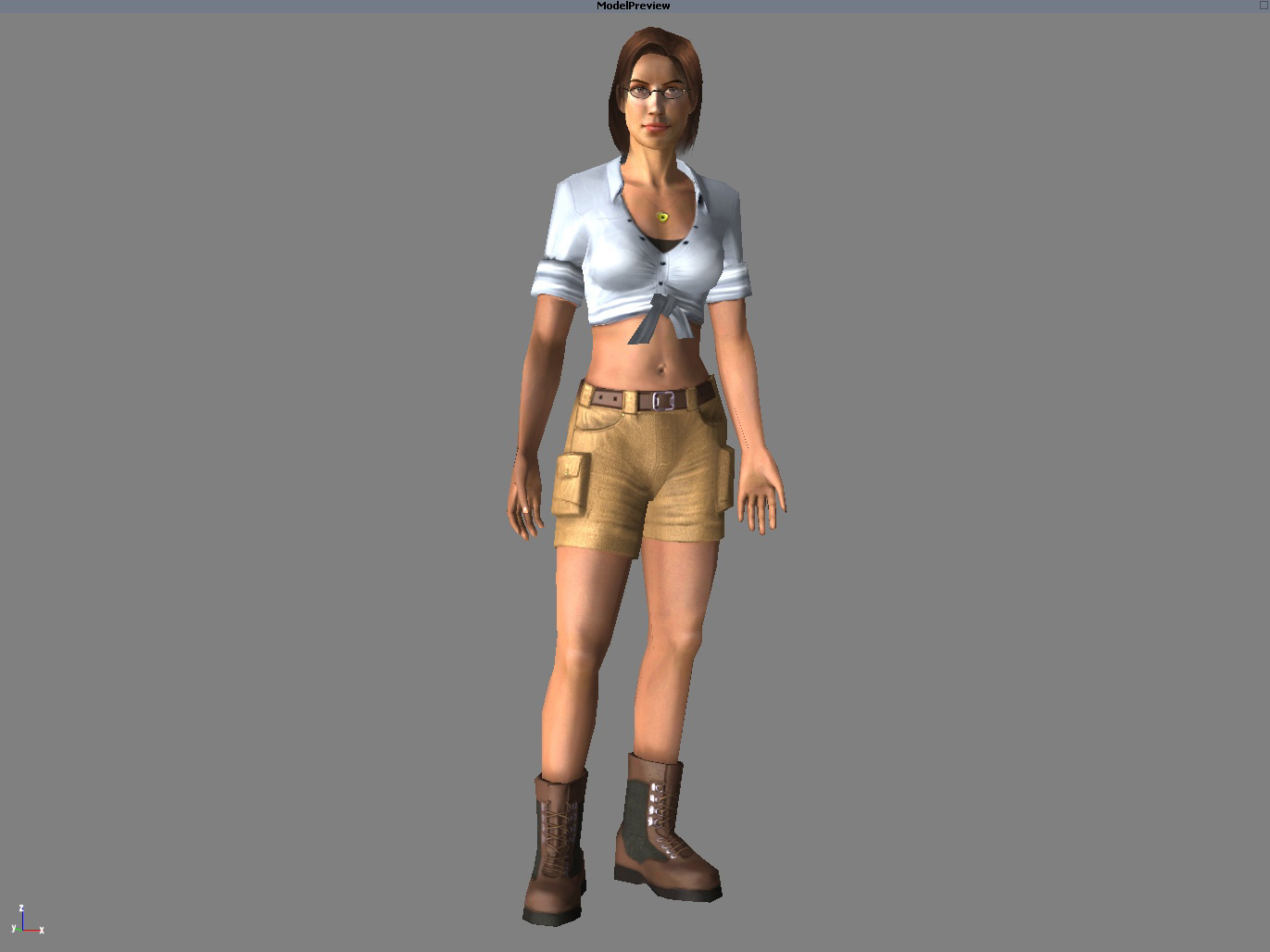
(by the way, none of these two models really match the description, but, curiously, the later resembles it more)
The mentor (Doyle prototype)
As for this character, he’s both quite similar and different from the release game’s Doyle.
By the way, he’s probably the only character whose name didn’t change at all during this envisioning period. And his name was:
Harlan Weaver
The given name made it into the final game. The surname faded into obscurity and got replaced with the Doyle we know.
His core role in the game is like the release version: a brilliant scientist, someone quite high up in Krieger’s chain of command, he secretly assists the player from a safe distance, providing information via the radio and stuff like this.
In contrast, his motivation for doing so is different. In fact, there were two proposed different reasons, along with accompanying personalities, slightly differing from each other.
He does what he does because...
a) because of feeling guilty for everything he has done while working with the main villain. And the surest way to keep thoughts away from his own wrongdoings would be dedicating himself to stopping his boss. Since Weaver is closely watched at all times, his only real hope is in letting the outside world know of the horrors his madman of a boss is creating. And for that, Weaver secretly contacts a certain journalist...
b) because of fearing for his own skin due to knowing too much. He has no remorse for what he has done. But due to his position (second in command, basically) he knows too much. And now that the main villain’s plans are getting close to completion, he is becoming increasingly less useful. He knows what is about to unfold, and intends to save himself by letting the outside world know the true extent of his boss’s operations.
This version is described as a person who is both ambitious and anxious, someone who answers a question with a question and hides his true motives.
This latter version is notably more villainous, somewhat more fleshed out, and also much closer to what we got in the end.
While Weaver uses the player to achieve his own goals, he would not outright betray the player during the endgame — another important plot point missing.
His appearance is also quite different from the release Doyle: a white man in mid to late twenties, tall-ish, medium-build, healthy, wears glasses, has short blond hair and a trimmed goatee. Usually wears stylish black boots and dark-blue trousers, black collared long-sleeve shirt, and a long white lab coat. Usually carries a red clipboard with paper and pen.
The mercenary leader (Crowe prototype)
And here comes the last familiar character.
His proposed names were:
-
John Mertz
-
Jack Mertz
While in the final game he is known as Richard Crowe, he is very often referred to as “Mertz” in the game’s files, so this name seemingly stuck for a while during the development.
He’s the leader of mercenary forces on the islands, travelling from place to place and overseeing operations.
Mertz is a man in his early forties. He comes from a shady background, after going AWOL from his unit after killing a superior officer. A hard man to earn the respect of, with little regard for human life, but with a lot of regard for money: he thinks he is onto a nice deal by working for the main villain, even while knowing the true nature of his operations. Still, he wouldn’t hesitate about bailing out when things go south. Trusts no one but himself, as his experience has taught him to be paranoid.
This character would be used in a speaking role to advance the story at key times.
Thus, he generally has the role Crowe would have in the end. Quite unexpectedly, Crowe’s prototype seems to be considerably more respected by his underlings than the final version.
And that’s where the familiar named characters end, and some new ones appear!
Village elder — Solomon Lopea
Appearance: a wise old man (in his sixties or seventies), thin and frail in appearance. Graying hair, deep tan, skin wrinkled and weathered by the tropical sun — like leather, with Polynesian/Maori tattoos.
Always has a sad knowing smile.
He was described as a sort of a tribal shaman in a modern context. He would see the good in the hero and his actions, and, would be there to help, in a roundabout way
Senator — Harris
Your fairly typical politician in a cheap gray-suit and glasses. Ugly looking, has balding gray hair and a fat nose. Someone who always has a sincere looking smile and manners — not sure whether to trust him or not.
He is contacted by Doyle in the ending in one of the storyline drafts.
It’s not hard to see why these two were cut. They are noticeably less fleshed out than the rest of the named cast, and they don’t have as much impact on the story. The senator wouldn’t really serve any role outside of the ending (more on that in the storyline section).
Miscellaneous characters
In this category were included groups of characters that are not named at all, but still relevant to the game — like mercenaries. As before, there is something new there.
Most all nameless human characters can be broken down into the following groups:
-
Mercenaries
-
Scientists
-
Islanders
Let us look at each of these groups in detail
Mercenaries
The “security force” protecting Krieger’s facilities, or, rather, a whole private army.
Criminals with military backgrounds, coming from the armed forces of all sorts of countries around the globe. Forced out for criminal behaviour or insubordination, bored of the battlefields of their homelands, they came to the main villain seeking new “opportunities” — to continue to do the only job they truly know and enjoy while being generously paid for it.
The mercenaries’ loyalty lies with Mertz, partly through respect and partly because the money goes solely through him. Mertz worked this arrangement out to protect himself from any lieutenants that might try to overthrow him. Because of his paranoia, his troops are very compartmentalized — none of them truly know the big picture of what they are defending, or what happens on the other islands. Thus, the mercs do not know — or don’t particularly care what they are defending. They are not in the main villain’s grand plan, but they are an indispensable tool in fulfilling it. Thus, as long as they do their job well, Mertz and his crew were pretty much given carte blanche, and that means they get to play with a lot of next generation weaponry and vehicles.
The rank-and-file grunts are described as brutal, crude thugs, war criminal types. Not overly intelligent but experienced in their trade.
They wear jungle (guerrilla) fatigues along with gear (mostly next-generation technology).
This concept from the last part fits the description pretty well:
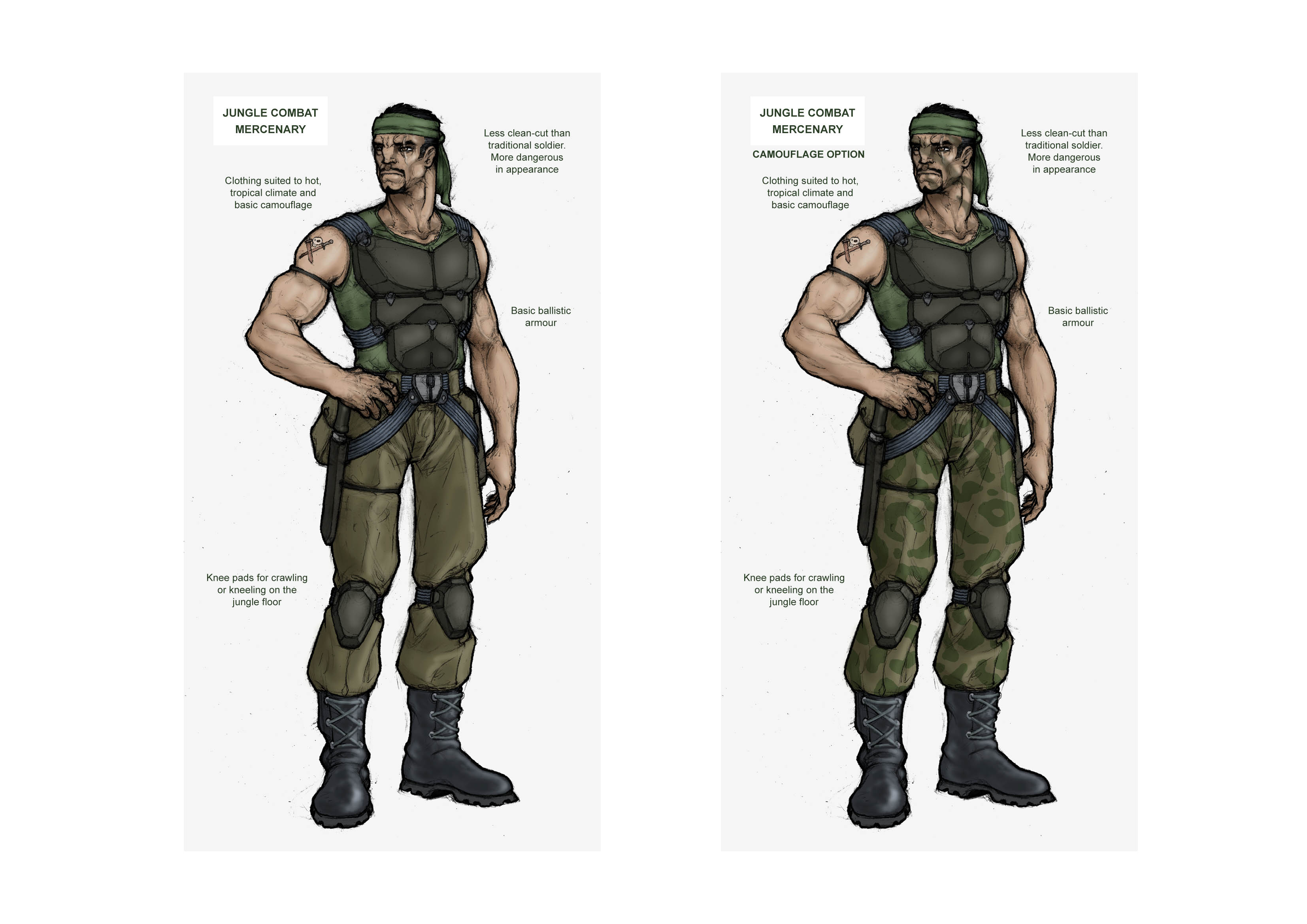
Their leaders are described as the more professional of the bunch, officer types with western military backgrounds (special forces). They are the disciplined, calculating minds within the structure of this secret army.
These guys would probably have bullet-proof vests, secondary weapons such as pistols and grenades, and mirrored sunglasses, short military/executive styled hair, an expensive watch and rolled-up sleeves, or, a plain green t-shirt and equipment definitely next-generation technology.
The mercenary commander concept from the last part fits this description splendidly:
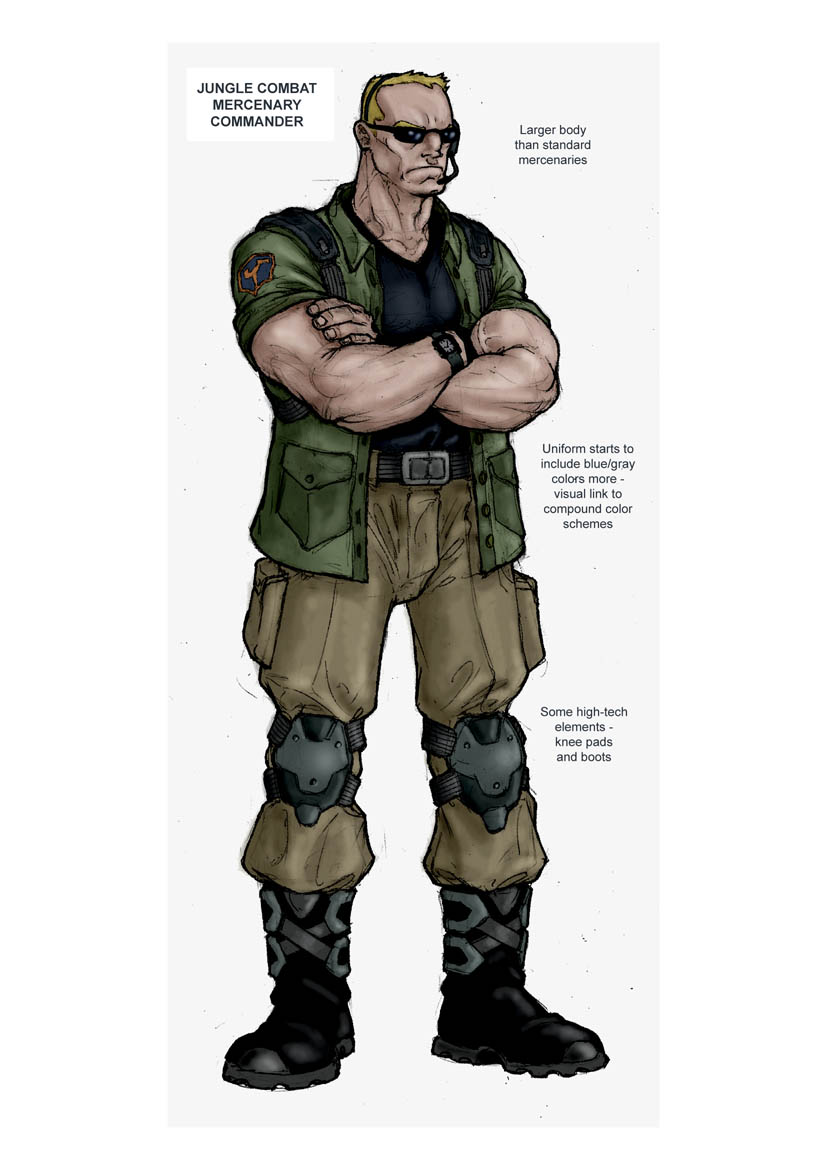
So, not that different in a meaningful way from the final game’s mercs. However, during the early stages of development (up to the E3 2002 Demo at least), their various roles, their “subtypes” (you know, Covers, Rears, Elite mercs, etc.) weren’t that clearly defined.
Scientists
The great minds that the main villain recruited to bring his plan to fruition. Nervous and intellectually arrogant, but, ultimately, gullible pawns. While some of them do quite unsavory experiments, few are completely aware of the actual nature, the full extent of the main villain’s “research”.
Appearance: both male and female versions are slim, thin, wear thick glasses (some don’t) and either really short hair (or crazy out of control fuzzy long-hair) for the men, or, long and parted in the middle (tied-back) hair for the women (maybe short haired versions), the women do not wear makeup. Both men and women pretty much look like plain Janes and Jims. They wear typical geeky/nerdy clothes: brown shoes, blue jeans and green polo shirts, with a white lab-coat over this, with a pen pocket protector full of pens, perhaps also other generic scientific instruments, such as a calculator and clipboard.
The impression they make is of people who need to stop living in the shadow of someone else’s or in the confines of their scientific work and get more in touch with the real world. Perhaps a few that deal directly with the “mutating people” department would be crazy in a “it has to be done for the good of all mankind,” kind of way.
Villagers
Here are the stars of this show that didn’t make it to the final game at all.
Proud but threatened people. Scared, but with a hint of defiance.
Abused test subjects.

The islanders were described as naturally strong and tall people with deep tanned skins; a few would have Polynesian/Maori tattoos. They live on isolated islands yet have had some contact with the outside world. They are a simple people with a modern yet simple way of life, that asks nothing of anyone else. Distrustful of outsiders, especially white outsiders.
Before the main villain bought great portions of the islands, they were inhabited only by relatively small villages, maybe not more than 3 to 5 villages per island. The big bad built his facilities in the center of the islands or as far away from the locals as possible, hidden in the dense jungle. The locals didn’t know anything about the real purpose of these labs, thinking it was some secret factory and staying away, as they were afraid of the whole army of mercenaries guarding the facilities.
However, soon enough… some of the islanders start disappearing. As it turns out, they are either being taken to be subjected to horrific mutations, or serving as living targets to test the new creatures’ abilities. Their normal life eventually becomes a nightmare...
And as the protagonist arrives on the scene, they get some much needed help, an opportunity to rescue some of their people and to resist the main villain.
Something like that. More on their role in the storyline section.
Non-human characters
In this category I included non-human creatures that appear in the game.
Mutants
Another cornerstone of Far Cry. As you can probably tell by now, mutants were actually intended to be a part of the game from the start as well.
Like most other things, they had a different name at the time. While they were usually referred to as just that, “mutants”, they had a fancier name as well. Instead of “trigens”, they were at some point called “splicers”.
In the final game, we have mutants that were created from animals (apes) and humans. Was it like this back in early 2002?
Not really.
Notably, all varieties that were made using animals as a basis (Aberrations, Chimps) were completely missing from the plan at the time. While animals were used for “gene harvesting”, they didn’t serve as a basis for creating mutants.
Their role was filled by Failed Mutants. They were similarly described as the results of early experimental genetic engineering techniques. They all possessed some defect or a missing factor that classified them as unsuccessful. Physically they appeared misshapen, deformed and scary. The threat they would project was more one of brute force and savagery.
Perhaps, from these we got mutants like Rear?
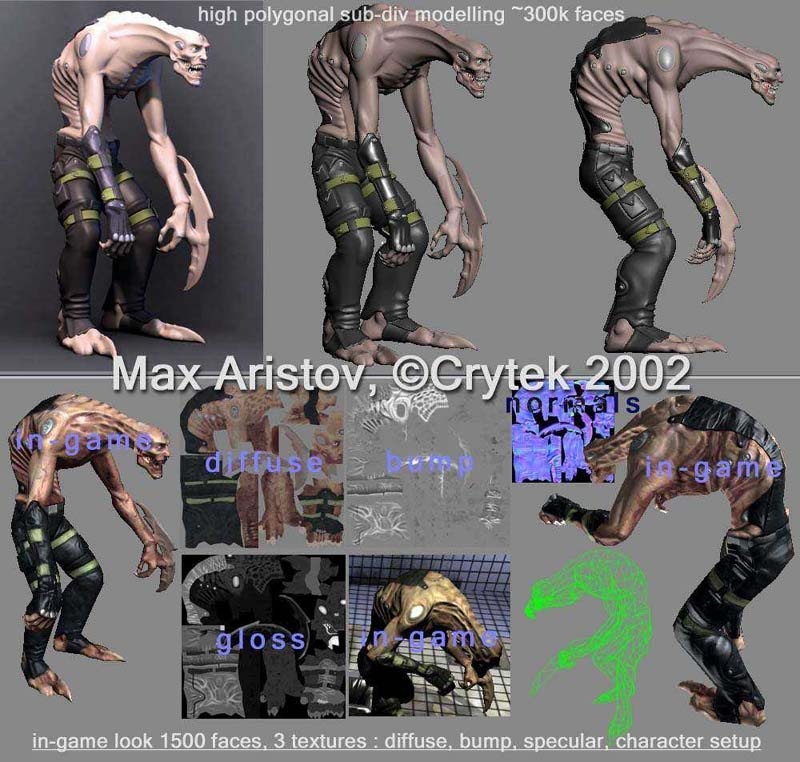
Another general type of mutants was the “Elite” Mutants
These beings were said to be specifically created to be more aggressive and more physically powerful than human beings, and subsequently trained to consider themselves superior to all other species on Earth. They were said to carry themselves with arrogance, sinewy grace and an overwhelming sense of focused, inhuman menace.
They were described as humanoid, taller than an average man by a foot, with large athletic builds. but still looking agile in frame and movement. They would not have any clear animal traits in appearance, but do have certain functional characteristics in their physiology — meaning that they may be able to jump high, but do not have frog-like looking legs — absolutely no cat-people.
They would be equipped with gear and weapons (next-generation) designed for them, but, since they were humanoid, the player should be able to use at least some of these, very much unlike the final game.
As for the actual specific varieties of mutants, they are totally different from what we see in the final game.
1) Electric eel
The Electric Eel is almost human in appearance, but has been spliced with genetic stock derived from the famous electric eel from the Amazon river. This means he has the ability to generate and store large amounts of electrical energy, and discharge it through any electricity conducting medium.
The mutant was described as being able to cast electricity from its hands through air, but his attacks would be more powerful if a better conducting medium is used. For example, if indoors, the Mutant may see that the player is standing on a metal walkway, and therefore run over to touch the other end of it. The electricity would travel along the metal and do more damage than if he had simply fired it through the air. Water and other liquids would again magnify the effect, but could cause harm to the Mutant.
A byproduct of the Cast Electricity ability is being able to generate a controllable electro-magnetic force field. By activating the coiled metal pieces on the Mutant’s arms, the electricity can be used to generate an electromagnetic field that has multiple uses, ranging from a shield (metal bullets are slowed and then stopped when they enter it) to a lifting ability — picking up an object made of or with some metal element in it, it can then be hurled long distances.
This amazing mutant has completely disappeared from the game during the development for reasons yet unknown. Perhaps, his abilities were too tricky to implement?
Sadly, we don’t have any concepts of this “Electric Eel”. Not sure if they even exist, but it would be great if we found them.
2) Strong guy
The concept behind the Strong Guy is strength, strength and more strength.
He was described like this.
His entire body has been designed from the genetic level up to be the peak of physical perfection. Muscles, tendons and sinews have been engineered to their limits.
Having the reflexes of a professional boxer, Strong Mutants have a long reach and can deliver vast amounts of close-quarter damage.
Besides that, large objects like boulders, trees and equipment can be picked up in the massive arms of this Mutant. Able to perform sustained power-lifting, this mutant can actually pick up and carry objects greater than its own body weight.
Once hoisted, most objects can be thrown — used as weapons
Strong Mutants would be used for purposes ranging from helping in the construction of airfields to carrying and firing very heavy weapons.
The Strong Mutant would have an excess of strength and stamina, but a low top speed. This means he could be picked off before actually reaching the player and being able to use his fists.
This Mutant is also said to not be particularly bright, lacking in creative thought and initiative. That said, when issued with an order it would attempt to carry it out at all costs
Well, I wasn’t telling the whole truth when I said the mutant varieties were completely unlike the final game. The “Strong guy” mutant could very well become Mutant Cover, and, subsequently, Mutant Big in the end. However, we have never seen these pick up and throw heavy objects in the final game or during development.
3) Some other varieties mentioned, but not described in detail, were:
-a “Spider-man” mutant — able to climb any walls just like spiderman
-a ”Fast and agile guy”
-”The senses guy”
-and some others
Well, it can be said that the specific mutant varieties weren’t that fleshed out at the time yet. Regardless, among them there already were already some incredible concepts that, sadly, haven’t made it into the final game.
Besides the mutant varieties, some aspects of the mutant creation and training process were described.
All mutants were stated at the time to come from two origins: there were humans genetically altered with some sort of virus and “pure” mutants, creatures completely grown in a vat. The virus-mutants were to be not as “superior” as the “pure” versions, but could be further enhanced with more and more “upgrades” — but too many would have adverse side-effects on the subjects. In addition, not having to rely on the original genetic code of a subject was supposed to allow more “creative freedom”. For these reasons the main villain’s research has led him to favour the “pure” mutants (clones).
The vat-grown clones were supposed to have accelerated growth cycles: a new-born could already walk and run about within an hour, just like some newborn animals do. Within a 3-month period they would have fully developed into an adult form – they would have a theoretical life span of 150-200 years and were built to last.
Still at an experimental stage, not all the “bugs” have been worked out of all these creatures; there had been no ‘Ultimate’ Mutant yet – the researchers were said to hope to achieve that by developing different strains independently, it would be easier to isolate the issues surrounding each ability, rather than creating an over complex super mutant from scratch. This would explain all the different varieties of mutants.
How were the mutants trained?
Every so often, the main villain would set up a test for a current batch of Mutants under differing circumstances. Some would be undertaken in underground proving grounds, others above ground on an unsuspecting village or placed into different natural environments and then test-subjects thrown in to see what happens — usually villagers but the odd group of mercenaries “new-guys” and redundant scientists. Sometimes, mutants were also to be put against other mutants.
What were the ideas about the behaviour of mutants?
After a period of time, the mutants would form a hierarchy within a group. Once this is established they would start to behave in a coordinated pack behavior — they were said to be very susceptible to becoming overly disorganized in behavior if the top-dog is killed, in a fight they may even start to form smaller groups, and may forget about you altogether. Before this hierarchy is established things tend to be disorganized and chaotic — they are fighting for dominance and status.
In addition to all this, the main villain’s specific plan of conquering the Earth was described in greater detail.
He intended to do this by releasing an engineered version of the virus that would transform humans (unless vaccinated, already mutated-humans or vat-mutants) into a "lesser mutant", animal-like, that would act as a pathogen and spread the disease — cannot reproduce, and only live on average for 3 months before dying. By releasing this virus he hoped to turn most of the world’s population into these creatures, and, effectively kill off the world’s human population, those left would give very little resistance to his mutant army.
Story synopsis
The story, in its core, remained unchanged from these drafts until the end. A Dr. Moreau-esque tale of a mad genius engineering vile creatures on his archipelago, and the player trying to stop him.
However, when you take a closer look, it had a number of differences.
Before I start telling you the story itself, I should note that in early 2002 it was still in the process of being established, so there were a number of variants that, too, had the same core. I am going to tell you an “average” version, and mention some notable differences.
To make naming the characters (they had different names, remember?) easier, I will refer to them by their release names in quotes.
With that out of the way, let’s go.
Introduction/Prologue
In the final game, Val hires Jack to get him to the islands on the pretence of taking pictures of WW2-era Japanese ruins.
As we found out before, there were no WW2 Japanese ruins in the plan at the time really, so what would be her reason to go there in these drafts?
Well, “Val” was supposed to be an actual journalist in these drafts. She would always look for a story that would make the headlines. One time on her searches she caught wind that “Krieger”’s company isn’t what it seems, and has a much more sinister actual purpose to it (even more sinister than biological weapons). And so, she sets off to get some material that would make an explosive story…
For that, she pays “Jack”, a boat skipper, to bring her to this isolated archipelago in Southern Pacific. The game would open on him and the journo talking on a yacht, exposing the introductory information.
“Jack” would drop the journalist off. He gets the first half of his money, the second half he would get once “Val” returns to this same spot after several days
…She didn’t return.
In one variant, “Jack” got to this spot, but only found her backpack not too far away. The backpack contains a camera, with pictures of hi-tech buildings in the forest, a radio and a pistol. Suddenly, an explosion can be heard in the distance — it’s his boat! Then “Jack” gets ambushed by mercs, but gets out of this situation successfully.
In another variant, “Jack” pulls away, moving out to sea to move along the side of the island. All the sudden he hears the sound of a mortar being launched. Soon, the boat is destroyed and “Jack” is thrown into the sea water. Some time later, he wakes up on the beach of the island, seeing debris of his yacht. One has the boat’s name on it, to really piss him off.
Regardless of minor variation, “Jack” readies his weapon, to get a payback for his boat, to find the journalist that got him into this situation and to escape this island.
You know what? All these old drafts greatly remind me of this trailer that was shown at E3 2003:
Neat to see the resemblance.
Moving on…
Beginning
“Jack” quickly discovers clues that something bad may have happened to “Val”. He goes deeper into the island, through a jungle and some open areas revealing the landscape. The environment is paradise, except for the fact that we’re fighting off some mercenaries..
“Jack” then finds a hi-tech facility in the middle of the tropical forest. Armed and uniformed men are guarding it. He finds a way in and learns about ongoing scientific experiments/research involving genetic engineering and humans. As he searches for a getaway from the island, “Jack” gets an uncomfortable feeling that some unusual things are happening on the island (other than the armed presence and “secret” facilities). Even though he hasn’t witnessed anything really horrible yet.
During this section ”Doyle” would be introduced, and would help us, for his own reasons. Also, “Jack” learns that “Val” is alive and he would show a growing concern over her fate.
Middle game
As “Jack” moves on, he learns more about “Krieger”’s plans while sneaking through the labs. When looking at “Krieger” giving a speech through a sort of an internal TV network, we would see that he is subtly, but noticeably “altered”. While traversing the island/s, “Jack” discovers that the locals (Polynesian-like villagers) are being used in the Dr’s “important” research. Because of that, villages encountered look more like very eerie abandoned ghost towns, as if everyone just left.
Also, “Jack” would at some point save a person who would turn out to be the village elder, Solomon Lopea.
“Jack” discovers that several compounds contain strange never-seen-before mutants.
They resemble humans, but behave more like untamed predators. When “Jack” goes near their holding-pens, they react and observe him like prey. We can imagine what kind of horrible experiments were made on them as some of them were clearly once human.
“Jack”, aided by “Doyle”, fights his way through to the inner labs where “Val” is going to be used as a genetic test subject. “Jack” has to shut down (destroying the main-controls) the power supply of the island complex to help and save her. Unfortunately, that will also release the mutants from their compounds – even though “Jack” did not figure that out, he basically has no choice about it.
Late game
Totally infuriated, “Krieger” sends more guards to kill “Jack”. Noticeably, “Krieger” gets progressively more altered. The fight is prematurely stopped by invading mutants that have broke out of their compounds. They start attacking the mercenaries. “Krieger” escapes in the middle of the chaos, taking “Val” with him. “Jack” can’t help it, as he has a hard time remaining alive himself while trying to escape the lab.
While initially disorganised and infighting, mutants would soon make “packs”, and the number of mercenaries would decline rapidly.
As the mutants get ever more numerous, “Jack” would cooperate with the locals and fight by their side, and also help to rescue some of their people that were captured to be used in “Krieger”’s experiments. At this point, “Jack” may also help the surviving locals escape this archipelago.
The final confrontation
In any case, “Jack” finds out where “Val” is being kept. He would set off to “Krieger”’s private island, helped by “Doyle”.
In one version, this final island has a familiar intimidating volcano. In another, it’s the abandoned, overgrown hotel resort mentioned above.
In all versions, “Jack” has to defeat the most advanced mutants that comprise “Krieger”’s personal guard, and “Krieger” himself, who has greatly altered himself and finally achieved his “ultimate form”.
Also, in one version, Krieger’s main base would contain a room full of his clones that the player could destroy.
Anyway, after that, “Jack” saves “Val”, before it’s too late, and they both escape on a boat.
Epilogue
There were a number of contenders for an epilogue that would promise another part, but this one was used the most prominently.
After “Jack” and “Val” leave into the sunset, we see “Doyle” being welcomed by western military forces led by the senator Harris (you know, the one we mentioned before) after getting off a helicopter, along with a few other scientists. Some army guys are off-loading some “samples” (crates) from the helicopter.
Gameplay
Before all other gameplay-related things, I would really like to tell you about one in particular. There were ideas for a game mechanic that ultimately left no traces in the development.
It involved taking control of mutants using a special weapon.
So, how exactly was it supposed to work?
The Mutant Control Sniper Rifle would be a rifle-like ray gun, constructed for controlling mutants during field testing, would “project” the user’s (for example, the player’s) mind onto the target for a limited time. This would allow the player to surpass the limits of his normal abilities: reach areas of the map that used to be inaccessible, put the mutants’ overpowered weapons to good use, and so on, and so forth.
When targeting an enemy with the weapon's sight, he is viewed in ‘x-ray’. The player would see the target's heart, lungs and brain.
Sniping these areas would produce different outcomes:
- If aimed at the heart, the weapon would kill instantly
- If aimed at the brain, the mutant would come under control of the player
- If aimed anywhere else, the weapon does little or no damage.
By the way, here is an accompanying image from that time. It was obviously a quick WIP illustration, as it uses a mercenary, yet refers to him as a mutant:
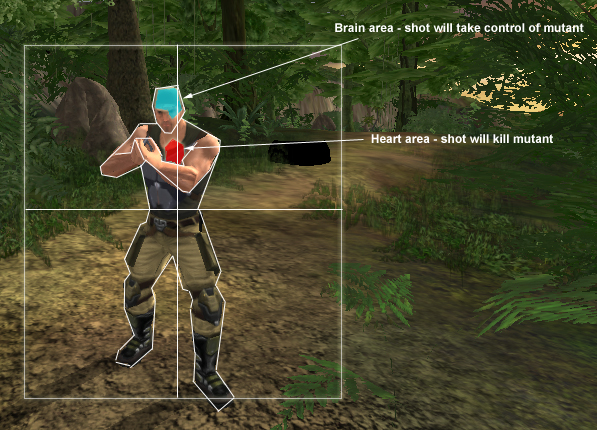
And this weapon would not work on mercenaries: even if aimed at the brain, it would just kill the mercenary.
It wouldn’t work on all mutants from the beginning either. It would need upgrades from time to time to overcome stronger foes or new mutants of a specific type.
Ammo for the MCSR could be limited, or its effect could last for different time periods depending on the size or ability of the mutant.
When the mind control effect would wear off, the mutant would stay where it was for some time, as if confused. The player could alternatively break out of control of the Mutant at any time with a single keypress, and return to his own body.
This ability to stop controlling the mutant at will would come in handy, as the player’s “main” body would still be vulnerable to attacks. Thus, the player would have to carefully choose a location where he wouldn’t likely be noticed by enemies during the mutant control process – tall grass, for example.
During the mind control process the viewpoint would change to the mutant’s, and the HUD would change (or disappear) accordingly. There would be some disorientation after the transfer of consciousness.
The purpose of the MCSR is to use the mutants as a tool to help complete the level.
Here are some hypothetical gameplay examples.
Gameplay example 1:
The player must retrieve an object from a high rocky ledge. There is no direct path to the object and all around it are multiple enemies, including an experimental Mutant type that can climb sheer rock walls like spider-man. If the player rushes in and kills everything, he still cannot retrieve the object. The optimal method of play is to find a safe area and snipe one of the spider-man mutants with the MCSR and bring it under the player's control. The player can then climb the wall by proxy, retrieve the object, return to the player and drop the object, revert to the player's control and kill the mutant.
Gameplay example 2:
The player must enter a restricted compound, but its gates are heavily guarded. There are too many guards for the player to overcome with brute force easily (although this is possible, at the expense of a lot of ammunition and health). An alternative solution would be to find a nearby mutant, take it over and cause a distraction with it – have it attack a nearby ammo dump, or set fire to it and have it run into the forest – anything to cause the guards to abandon their posts.
Mutant abilities would be designed in a way that means a mixture of ‘tools’ can be used. Combining mutants’ abilities, using multiple mutants, etc, would give rise to the player defining their own gameplay.
What an amazing gameplay mechanic, right?
It is not yet clear if it was ever implemented in any way at any point. It is obvious, however, that it would be quite hard to do this, and it would probably be quite the game breaker.
As for the rest of gameplay mechanics, from the start to be-Far Cry was intended as a first-person sorta-tactical shooter. Expect a lot of similarities.
It would be a fairly linear game, where the player could complete his objectives in a variety of ways. To assist the player, there would be a wide array of weapons, with short-range, long-range and stealth options. Also, there would be usable vehicles.
Still, there are some differences worth mentioning.
First, the weapons. Weapons roster listed was like the Far Cry E3 2002 demo: generally the same as the final game, with a couple of new guns (G11, Mortar) and some weapons missing (Machete).
However, in addition to those, there were plans to make two of the next-gen weapons used by humanoid mutants to be also usable by the player.
There would be deployable weapons (you could carry them, but they could only be used when deployed), like the anti-materiel rifle (NTW-20?) and a heavy machine gun.
Also, don’t forget the possibility of Mutant Control Sniper Rifle being added.
There was also a curious proposed weapon – Acoustic-Vortex: this next-gen sound weapon would create a compressed acoustic-vortex (that travels at high speeds) that would knock-over and suppress enemies at the lower setting, at higher, would break limbs and turn internal organs to mush.
More importantly than small differences in weapons roster, there were differences in the weapon system itself.
Remember the pistol melee anims? These are the vestiges of the old ideas for weapon modes.
A curious concept, which was supposed to work like this:
Each weapon could have multiple weapon modes, each mode could have two attacks, primary and secondary. The example below is for the rocket-launcher:
Weapon mode 1 – Normal:
Primary Attack – Free-aim: fires a single rocket that is untargeted.
Secondary Attack – Side-thwack: uses the side of the launcher to bash with.
Weapon mode 2 – Scoped:
Primary Attack – Lock-on single: fires a single targeted rocket.
Secondary Attack – Lock-on multi: can fire up to three targeted rockets.
The default secondary attack is a close-combat attack – such as a pistol whip or rifle butt – for the device in question currently held in the player’s hands. For those weapons that have a secondary attack, such as an auxiliary-grenade launcher, this default is only used when that attack is out of ammo.
So, as you can see, this old weapon mode system definitely left its traces in development – these pistol whip animations, the RL firing a targeted rocket when using a scope in the E3 2002 Demo.
Thus, our ideas for a weapon system rework are actually not that unfounded at all, hehe.
Next to normal weapons, there was always a place for grenades of all kinds. And oh boy, there so many more types of these mentioned:
the familiar
- HE/Frag
- Flash
- Smoke
the new
- Acid
- EMP
- Gas
- Choke
- Hallucinatory-gas
Notably, the humble, simple rocks used for distraction are completely absent from the plan at the time.
The grenades were supposed to be used in a manner similar to the final game: select a type and press the button to throw it while holding a weapon. It’s not clear why there are animated models for grenades as a separate weapon. Experiments, perhaps?
Besides just the types, there were grenade-related mechanics:
(detonation-related?)
- Time-delay
- Impact
- Proximity
(movement-related?)
- Bounce
- Sticky
No info on how they were supposed to be implemented though.
Both the planned grenade types and grenade-related mechanics left their traces in the scripts of the final game.
Secondly, the items.
Besides the familiar ones (Nightvision and Heatvision goggles, Binoculars, etc) there were more items at our disposal:
- Gas mask
It would negate gas effects such as chemical (poison and hallucinogenic) and biological (viruses) either from weapons or contaminated locations
Likely, it didn’t make it because it turned out there aren’t that many “poisoning” things in the game.
- Simulator
This one’s interesting: it would simulate the sporadic gunfire of a rifle; it would makes enemies think that they are coming under suppressing fire from a position and gets their attention away from the player’s activities
It was likely made obsolete when more sensible throwable rocks appeared.
- Protective goggles
They would make it hard to see things (e.g. everything red – hard to make out objects at times) but in return they would negate flashbang blinding.
- Health and armor pickups could have more variation, “tiers” (i.e. helmet and vest for armor, bandage or medkit for health)
- There would be items that would increase the amount of ammo you could carry – Backpack and Webbing
- Proximity Mines were also mentioned, likely used for ambushing the enemies
- Again, the mysterious Energy-related items: battery cell and battery pack. Possibly, these power the likes of the nightvision goggles.
As for the usable vehicles, the planned list was substantially shorter than what we got the final game. Just the Humvee, the Quad, and the Patrol boat (possibly, something like the one on E3 2002 Demo map).
Last, but not least, the enemies. The player would be opposed by a number of enemies with a kinda-sorta realistic behaviour. They would not just run at you, but use tactics, cover, reload their weapons, etc. This obviously applies to the mercenaries, but some of the more humanoid mutants would behave smartly as well.
Some interesting tidbits of gameplay-related info on mutants:
-Some mutants would regenerate, so you really need to pump bullets into them to make sure that they are dead - otherwise they may get back up,
-Some mutants could regulate their body metabolism and lower their temperature, while not moving, or only slowly, so as not to be detected by thermal imaging
-One type could see well in the dark but are really easily neutralized by large flashes . They would hide in the dark and only come out at night, disliking daylight (too intense) - a night-time predator
-Another may have had poor eyesight but hear extremely well.
Mission layout
Besides the storyline progression, some actual planned ingame missions’ layout was described. I’ll tell you some of the most interesting stuff.
A freighter defence mission
A rather interesting idea of a mission that didn’t make it to the final game at all.
The player has just helped the freighter that is packed with islanders escape the Deep Sea Harbour. It now moves out to sea, making a dash for international waters — twelve nautical miles distant.
It’s flight has not gone unnoticed by the Mercs however — they realize it has been hijacked, and whoever is on board could blow the whistle on the islands and their secrets. Once the ship reaches the safety of international waters there will be little they can do, so all effort is made to stop or sink the freighter.
The player must defend the fleeing cargo ship from attack. The Mercs launch aircraft (V22, etc.) and patrol boats in an attempt to intercept the freighter; the player must destroy the attackers before too much damage is done to the freighter and before enemy troops are landed on its deck.
The player controls a Patrol-boat (in third person) with two weapon systems (machine gun and rockets) on board with infinite ammo. The player must circle the freighter and repel incoming attacks, increasingly more intense, by destroying the enemy vehicles.
Not just the vehicles — the missiles shot by the enemy crafts could be destroyed before they reach their target. They could also be spoofed by firing parachute-retarded flares from the rear of the Patrol Boat. The player must drive in front of the incoming missiles (they are quite slow and easy to spot) and fire them to stop the freighter being hit. Reloading of the flare launcher is relatively slow, meaning that some damage will inevitably occur to the freighter.
The distance the freighter has to travel is divided up into 3 sections bordered by 2 ‘checkpoints’. When a checkpoint is passed the player is told how much distance is left to cover.
Near the end of section 3, a whole submarine controlled by Krieger’s forces surfaces in the path of the Freighter and opens fire with its deck mounted missile launcher. This is essentially a ‘Big Boss’ — the player will need to conduct several attacks on the submarine to destroy it. By this time the Freighter will probably be quite badly damaged.
In our discord announcement, I’ve shown the schematic of this mission as a teaser:
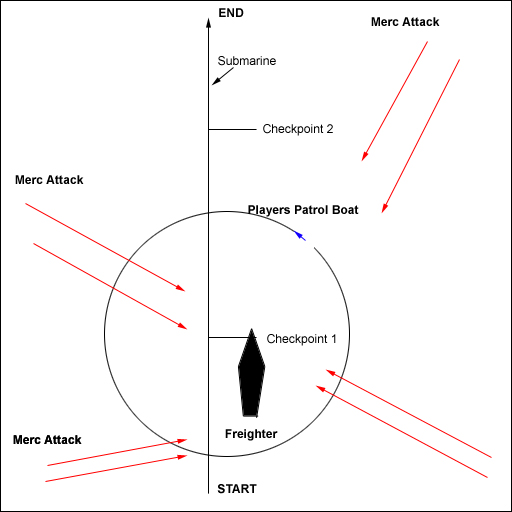
The final mission
This layout obviously comes from the time when it was planned to happen on a volcano.
The man-made structures placed on the volcano are modeled after the Arecibo observatory:
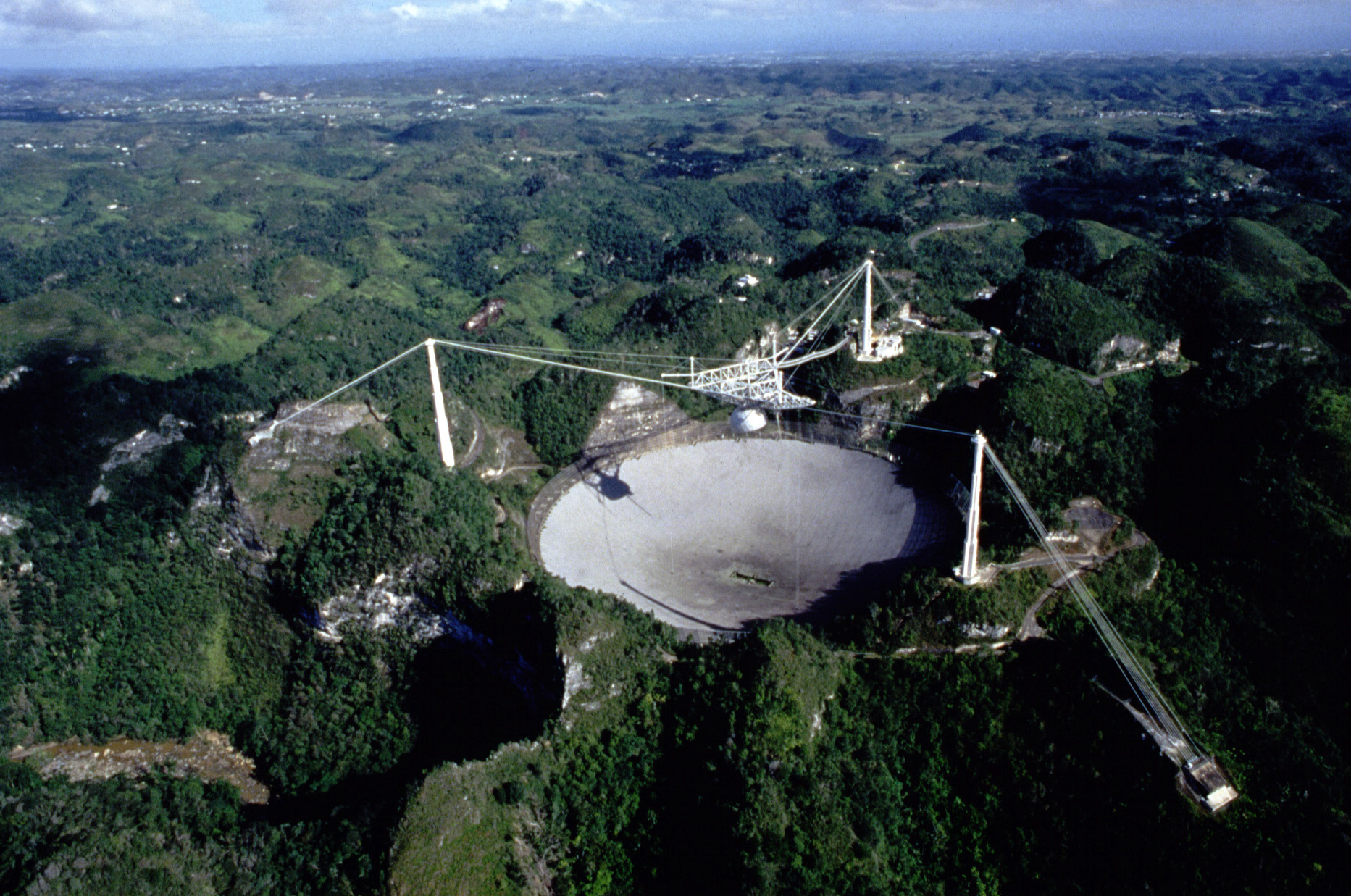
It’s not hard to see the resemblance, especially with the concept art of Volcano:

But what was the supposed purpose of this structure, at least during this envisioning period?
The purpose of this structure is to hold the Mutagen material that would be projected into the atmosphere upon the detonation of the volcano. When the material has been spewed tens of thousands of feet into the air, stratospheric winds would distribute it over the whole of the earth. The intense heat of the eruption would activate the material, allowing it to begin the mutation process as soon as it lands with the light ash – a genetically deadly cloud of ‘fallout’.
The Bad Guy plans to artificially detonate the volcano by exploding a large bomb on a fault line nearby; this would open the volcano’s magma chamber to the sea – millions of tons of sea water would rush in and be instantly vaporized by the incredible heat. This would of course cause a steam overpressure which would blow the entire volcano and fault line right out of the sea.
As for the actual gameplay, in general it’s just like what we’ve got in the final game: a mix of close-quarters indoor combat and some long-range outdoor combat. It would be the 14th, and, obviously, the last.
A schematic of the mission:
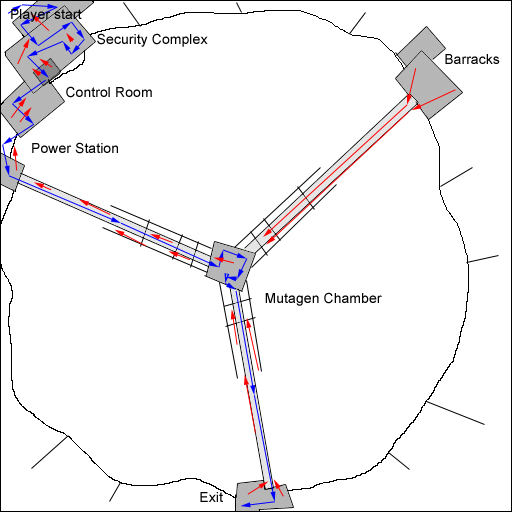
So, how can I sum up all of this?
Time and time again, we say how pre-release versions of Far Cry were so much different to the final game. Well, they really were, but we never appreciated how the game’s core survived basically unchanged — ever since the initial drafts, as we found out
Will we remake this stuff?
Depends. Some we already intended to remake — the weapon system, for example.
As for the stuff that know barely anything about, like some mutants and the resort — not at all likely.
Well, that’s it for now. Stay tuned for a new part. This time, it would have much more in the images department.
Also, Merry Christmas and a Happy New year!
This sure took me a while to finish.
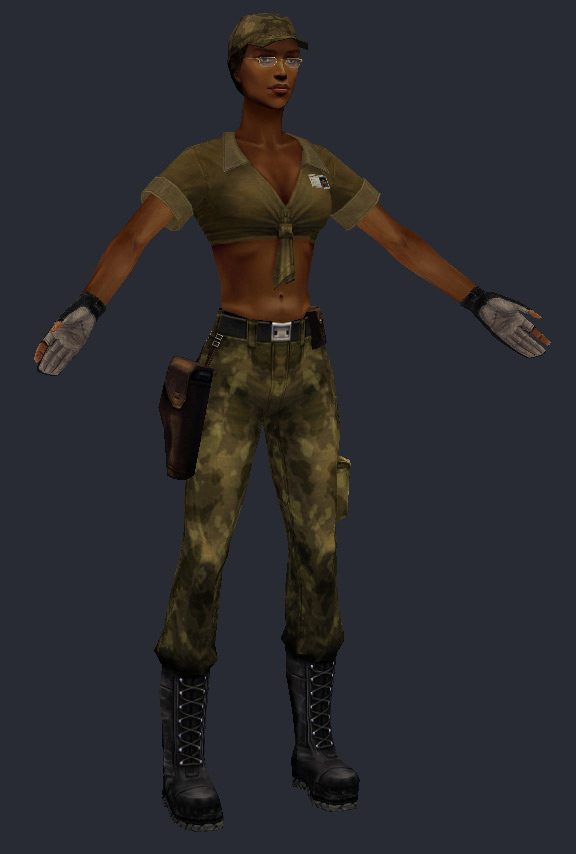


great, i relly like this kind of post, Merry Christmas and a Happy New year tou you bpr and team
Always nice to get more inspiration for modding :) Merry Christmas!
Amazing article like always, and Merry Christmas!
Thanks Marek. Merry Christmas to you!
Never knew there was this much to dig up on Far Cry! Hoping the next article showcases more of the mod itself! ;)
Merry Christmas!
Absolutely stunning read, this is a goldmine for the Far Cry Community!
In a sense this huge article reminds me of the "Deus Ex Continuity Bible": a document compiled by the developers who worked on Deus Ex 1 (Ion Storm). This was the road map they used to develop their game. Of course many features never made it into the final product (like the Moon level or the female JC Denton).
It's important because the "Deus Ex Continuity Bible" served as a resource for quite a few Deus Ex Fan-made Mission (like Zodiac or Nihilum for instance).
My point is: these kinds of articles could surely serve as an inspiration for the Far Cry Modding Community. Many thanks for unearthing these juicy tidbits.
Edit: Merry Christmas, Folks! ^^
Just stumbled across this project and endet up reading the whole article.
Far Cry 1 was the only part of the series that I really liked (although it had its flaws) and went through several times (Vanilla).
Nice. Would you play a mod, or is more interesting to read about the beta features?
FYI all four island names are kept in the retail game, Doyle drops some of them, while Amulong is heard through merc dialogue, being the island where Treehouse and Bunker missions are set.
Cabatu is the Fort island, Jacutan is the one where Regulator, Control, Rebellion and Archives are placed, while Pagao is the last island you visit from Catacombs until the end of the game
Thank you for these detailed articles about Far cry! I read all 10 articles, as an indie developer it was interesting how one of my favorite games was developed.